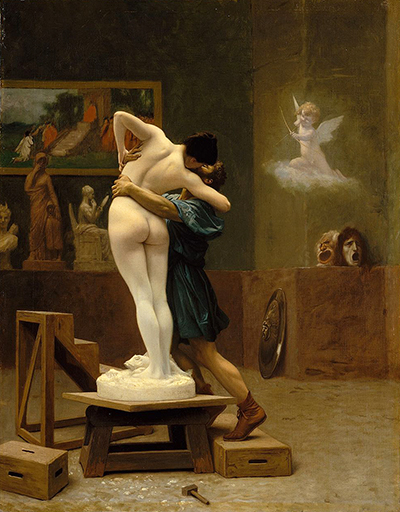Jean-Leon Gerome was a painter and sculptor who explored the theme of Pygmalion in multiple art forms. His artwork is based firmly in academia and along with painting he was a teacher with a wide variety of students.
Pygmalion and Galatea was painted in 1890 as oil on canvas. It shows Pygmalion the sculptor kissing his created statue of Galatea, just as the goddess of love, Aphrodite, makes her come alive. Gerome painted the subject of Pygmalion and Galatea several times, each from different visual perspectives. Several of these paintings appear in the background of Gerome's self-portraits, suggesting the artist's close identification with the subject matter. Whilst painting Pygmalion and Galatea, Gerome also fashioned his own Galatea from marble, giving himself a real life version to capture on canvas.
Not just content with bringing to life figures from Greek mythology, Gerome was also a historical painter, capturing moments from historical narratives. As a young man, he left his native France to travel extensively through Italy and his academicism is a reflection of his breadth of interests. He gained sudden success when championed by famous French art critic, Theophile Gautier, and over the course of his career he won several medals at the prestigious Paris Salon. As a result of the popularity of his work, Gerome was commissioned to paint for Napoleon III and the financial status he gained from this allowed him to travel further to Greece, Turkey and Egypt, all places that inspired him and appear in his works.
Pygmalion and Galatea was painted at the latter end of Gerome's career and examines the artist's connection to his subject. His foray into sculpture didn't occur until he was in his 50s, and this painting sees the marrying of both his passions, old and new. Around the time of the painting, many Tanagra figures had been excavated in Greece and Gerome drew inspiration from these to make Galatea as real visually as possible. The overall style is theatrical and evocative, with Gerome clearly seeing himself interconnected with the cyclical love affair between artist and muse that has always existed since ancient times. The version of Pygmalion and Galatea showing Galatea from the rear, which is perhaps the most well known version, is currently on display in the Metropolitan Museum of Art.




